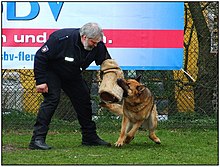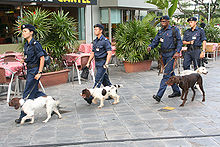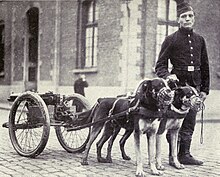Service dog
A service dog is specially trained for the sovereign responsibilities working dog . Service dogs are used in particular by the police , customs and the military . Service dogs are used internationally by the relevant government organizations. They are led by a service dog handler.
history
A police-like activity of a service dog was first known at the beginning of the 12th century when city guards used a dog in the French port city of Saint-Malo at night. Police dogs also became known in England in 1816 for tracking down whiskey smugglers. In 1896 the city of Hildesheim hired Great Danes for night watchman services , which the cities of Schwelm and Braunschweig joined.
Service dogs were not used in Germany until 1900, when gendarmes took their dogs with them on patrol. The first use is said to have taken place on October 1, 1901. The police reformer Franz Friedrich Laufer also promoted the introduction at the beginning of the 20th century.
When a great dane in the police service kept people away from the danger spot in a major fire around 1902, the police service dog was born. When a police dog tracked down a murderer in Braunschweig in 1904, dogs were not only used for protection, but also to compare scents in police investigations. Service dogs were also used in concentration camps during the National Socialist era .
Special training for police dogs was introduced in the 1970s. In 1972 there were the first drug detection dogs in Hamburg. In 1976, explosives detection dogs were added in Hamburg and Rhineland-Palatinate. Much later, money tracking dogs were trained.
Service dogs are equipped with additional equipment. In the case of tracking dogs and mantrailers, this includes the long tow leash with which the dog handler can lead on the long leash, tracking transmitters for the dog so that it can be located outside of the visual range, and bulletproof vests for guard dogs.
Use of dogs by the police
As operational resources of the police service dog formally a means of physical violence (see. Direct force ). For the legal situation in Austria, the Arms Use Act §10 Service Dogs is decisive. Service dogs are used by police forces practically all over the world. Dogs of the recognized service dog breeds are mainly used as service dogs. "The service dog breeds were once defined by the working group of the service dog-keeping authorities in Germany." In Germany these are:
- Airedale Terrier
- Belgian shepherd dog
- Bouvier des Flandres
- German shepherd dog
- German boxer
- Doberman Pinscher
- Hollandse Herdershond
- Hovawart
- Giant schnauzer
- rottweiler
In principle, however, other breeds or mixed breeds can also be used as service dogs. As sniffer dogs z. B. different breeds of hunting dogs ( retriever , spaniels , terriers ) are used.
Police dogs are trained and used for various tasks:
- Schutzhund
- Sniffer dog
- Drug tracker
- Explosives detection dog (various explosives, but also weapons and ammunition)
- Incendiary sniffer dog
- Corpse detection dog
- People search dogs ( mantrailing )
- Money sniffer
- Disk sniffer
Use of dogs at customs

Just like the police, the customs administration uses service dogs as protection dogs and detection dogs in the entire range of tasks to detect drugs , weapons , explosives , cash , tobacco , products of animal origin (ETU) and other illegal substances or goods with restrictions at airports, EU external borders, to be found in private homes, on motorways and at the border (see smuggling ). In addition to actively referring dogs (scratching), passive dogs are also trained who can find a find in silence and without any indications that an outsider can recognize, e.g. B. at the customs control , show (see passive dog ).
The use of guard dogs at customs takes place in the border inspection service as well as in the traffic routes control units (formerly mobile control groups).
Service dogs of the German customs are led by customs dog handlers and trained nationwide in the customs dog schools in Bleckede and Neuendettelsau .
The following rule applies to customs dogs in Germany with regard to service dog breeds: “Only dogs of the recognized service dog breeds Schäferhund, Rottweiler, Giant Schnauzer, Airedale Terrier and Bouvier des Flandres may be purchased and trained as protection dogs at customs. A specific breed of dog is not required for drug detection dogs. However, mainly Cocker Spaniels, Labradors and dogs of the service dog breeds are used. "
Use of dogs in prison
To support the prison system , prison officers use service dogs as protection dogs and drug detection dogs.
Use of dogs by other authorities
In some countries, sniffer dogs are used to monitor compliance with quarantine regulations when transporting agricultural products. In Australia and New Zealand, these dogs are assigned to the respective Ministry of Agriculture, in the US they are now of the Department of Homeland Security belonging U.S. Customs and Border Protection . Such dogs are also used in Canada, where they are in the service of the Canada Border Services Agency , which performs both customs and food control tasks.
Use of dogs in the military
Dogs were used for military purposes well before the 20th century. Dogs were reintroduced to France in 1908 by Lieutenant Jupine. Germany , Russia and Italy quickly followed. The British Army used Collies, or Scottish Sheepdogs, in the Transvaal War . In the maneuvers from 1911 to 1913 in Belgium good experiences were made with these dogs. War dogs in the First World War were used, among other things, as reporting, medical and load carriers. A common form of organization for the deployment is the military dog squadron . In the High Vosges, France used sled dogs to take care of the mountain troops and hunters.
Possible uses:
- Schutzhund
- Guard dog in security units
- Person tracking dog ( mantrailing ) in the fighting force
- Medical dog for tracking down the wounded and bringing bandages
- Explosives detection dog in the combat force and pioneers
- Drug detection dog in the police force
- Anti-tank dog
- Pull dog (pulling heavy machine guns and other heavy weapons)
- Transport of ammunition e.g. B. Loading strip with 120 cartridges
- Reporting dog for delivering reports
- Combat / danger defense dog to ward off enemy dogs
Use of dogs in the German Bundeswehr
In the army service dogs are in operation and are used in the paratroopers , the Air Force security force , the engineering corps and in the military police . Both protection dogs and explosives or drug detection dogs are used by the air force security force as well as by the military police. The paratroopers as well as the special forces command mainly use protection and personal detection dogs. Explosive ordnance and mine detection dogs are used by the pioneers.
Each of the eight military police battalions of the Bundeswehr has at least one company in which these service dogs, six drug detection dogs and six explosives detection dogs, are organized. The suitability to be a Schutzhund is only considered secondary, since the main focus of the training was placed on the dogs' detection abilities. German and Belgian shepherds are mainly used in the Bundeswehr. When searching for mines, the pioneers mainly rely on the Labrador Retriever because of its calm, balanced nature .
The dogs are trained in the Bundeswehr Service Dog School to become a security service dog , a field hunter service dog and, based on this, partly to become a personal sniffer dog, mine sniffer dog, explosives dog or drug sniffer dog. Up until the 1990s, the usual training was to become a guard dog.
The dogs are led by trained service dog handlers (abbreviation: DHFhr ).
Use of dogs in the Austrian army
In Austria, military dogs and their handlers are trained in the Kaisersteinbruch military dog center . There are around 250 dogs in the armed forces at home and abroad (as of 2006). The Rottweiler is the defining breed.
Training of sniffer dogs
The basic training of a police dog takes about 70 days. He is taught how to find evidence, track and detain people, and do some obedience exercises. He also learns to protect his handler. After completing its basic training and then once a year, the dog is tested according to the ordinance of the test regulation. Only when the dog handler has achieved at least a sufficient grade with his dog, the dog can be accepted into the public service. After the exam, his field of work is very diverse. He has to protect his dog handler from attacks, confronts fleeing perpetrators or looks for missing children or other helpless people. For further training as a police sniffer dog, a pronounced play and prey behavior and safe environmental behavior are required. During play, the dog is taught how his "toy" smells. For this purpose z. B. filled a plastic tube with a substance that smells like hashish . Little by little, the dog recognizes the toy by its smell and is actually looking for its toy. If he has found his supposed toy, he shows this either by an active display (scratching) or a passive display (sitting or lying, fixing the place of discovery with his eyes). As a reward, the dog now gets his toy and he can play with it. Later on, the toys' smells become more complex and can be combined.
For a long time now, the authorities have refrained from training under duress , because playful training and the targeted promotion of desirable behavior achieve better results than an act that is unpleasant for the dog.
Legal regulations
Germany
The ordinance on exceptions to the ban on bringing dangerous dogs into the country (Hundeverbringungs- und -einfuhrverordnung - HundVerbrEinfVO) lists service dogs. According to § 2 Para. 1 HundVerbrEinfVO, dogs "which are used as service dogs of the federal government, in particular of the armed forces, the federal police or the customs administration, as service dogs of the states, in particular of the police, as service dogs of the cities and municipalities, as service dogs of foreign armed forces should"; be imported into the country.
Austria
The use of service dogs against people is regulated in Section 10 of the Weapons Use Act 1969 and is subject to the provisions on the use of weapons. The general conditions for their training are laid down in the Service Dog Training Ordinance.
Switzerland
In Article 69 of the Animal Welfare Ordinance, dogs are classified according to their intended use. Service dogs (along with others such as rescue and handicapped dogs) belong to the class of working dogs. "Service dogs are dogs that are used in the army, the border guards or the police or are intended for it."
References
See also
literature
- Thomas Baumann: New ways of police dog training. Kynos Verlag , 1996, ISBN 978-3-929545-50-0
- Urs Ochsenbein: The dog training according to Urs Ochsenbein: From everyday companions to service and rescue dogs. Müller Rüschlikon Verlag, 1st edition, 2004, ISBN 978-3-275-01498-9
Web links
- Organization of the German customs dog system ( website of October 18, 2010 ( Memento of February 20, 2009 in the Internet Archive ) in the web archive)
- Service dog school of the Bundeswehr
- Swiss Police Dog Handler Association SPV - Association of Swiss Police Dog Handlers
Individual evidence
- ↑ The history of the police dog at: Reiter- und Diensthundführererstaffel Hannover ( Memento of the original from October 3, 2011 in the Internet Archive ) Info: The archive link was inserted automatically and has not yet been checked. Please check the original and archive link according to the instructions and then remove this notice.
- ↑ | Police Osnabrück - money tracking dogs
- ↑ Zolloberamtsrat Hans-Dieter Beckmann in an interview (PDF; 2.3 MB) in Der Arbeitsundund 1/2008 p. 37
- ↑ a b The customs dog industry has an almost 100-year-old tradition in Germany Article from www.zoll.de from December 25, 2010 ( Memento from December 25, 2010 in the Internet Archive )
- ^ Service dogs in the Braunschweig Police Department
- ↑ Working aids and tools from the customs administration website from zoll.de from September 21, 2008 ( Memento from September 21, 2008 in the Internet Archive ) in the web archive
- ^ Detector Dogs - Australian Government, Department of Agriculture and Water Resources
- ↑ MAF Biosecurity New Zealand Detector Dog Program ( Memento of the original from October 4, 2012 in the Internet Archive ) Info: The archive link was inserted automatically and has not yet been checked. Please check the original and archive link according to the instructions and then remove this notice.
- ^ US Beagle Brigade is First Defense Against Alien Species
- ^ Detector Dog Service
- ↑ L. Hoffmann: The book of healthy and sick dogs . Moritz Perles publishing house, Vienna 1901, Ueber die today's war dogs, p. 409 ff . ( online ).
- ↑ Sled dogs for the front documentary film Marc Jampolski ( page no longer available , search in web archives )
- ↑ Viktor Suvorov, Speznas: Secret behind Glasnost, Dissberger 1989, ISBN 978-3-924753-25-2
- ↑ Partner on four paws. The military dogs in the Austrian Armed Forces
- ^ Berlin police: Directorate ZA - service dog handler. Basic training. ( Memento from December 14, 2011 in the Internet Archive )
- ↑ Ordinance on exceptions to the ban on bringing dangerous dogs into the country (Hundeverbringungs- und -einfuhrverordnung - HundVerbrEinfVO)
- ↑ Federal Act of March 27, 1969 on the use of weapons by organs of the Federal Police and municipal guards (Weapons Use Act 1969) , StF: Federal Law Gazette No. 149/1969, as amended
- ↑ Ordinance of the Federal Minister for Health and Women on Measures for the Training of Service Dogs of the Security Executive and the Federal Armed Forces (Service Dog Training Ordinance - Service Dog Training Ordinance) , StF: Federal Law Gazette II No. 494/2004, as amended
- ↑ Animal Welfare Ordinance (TSchV) of April 23, 2008 (as of January 1, 2011) Art. 69 para. 3







